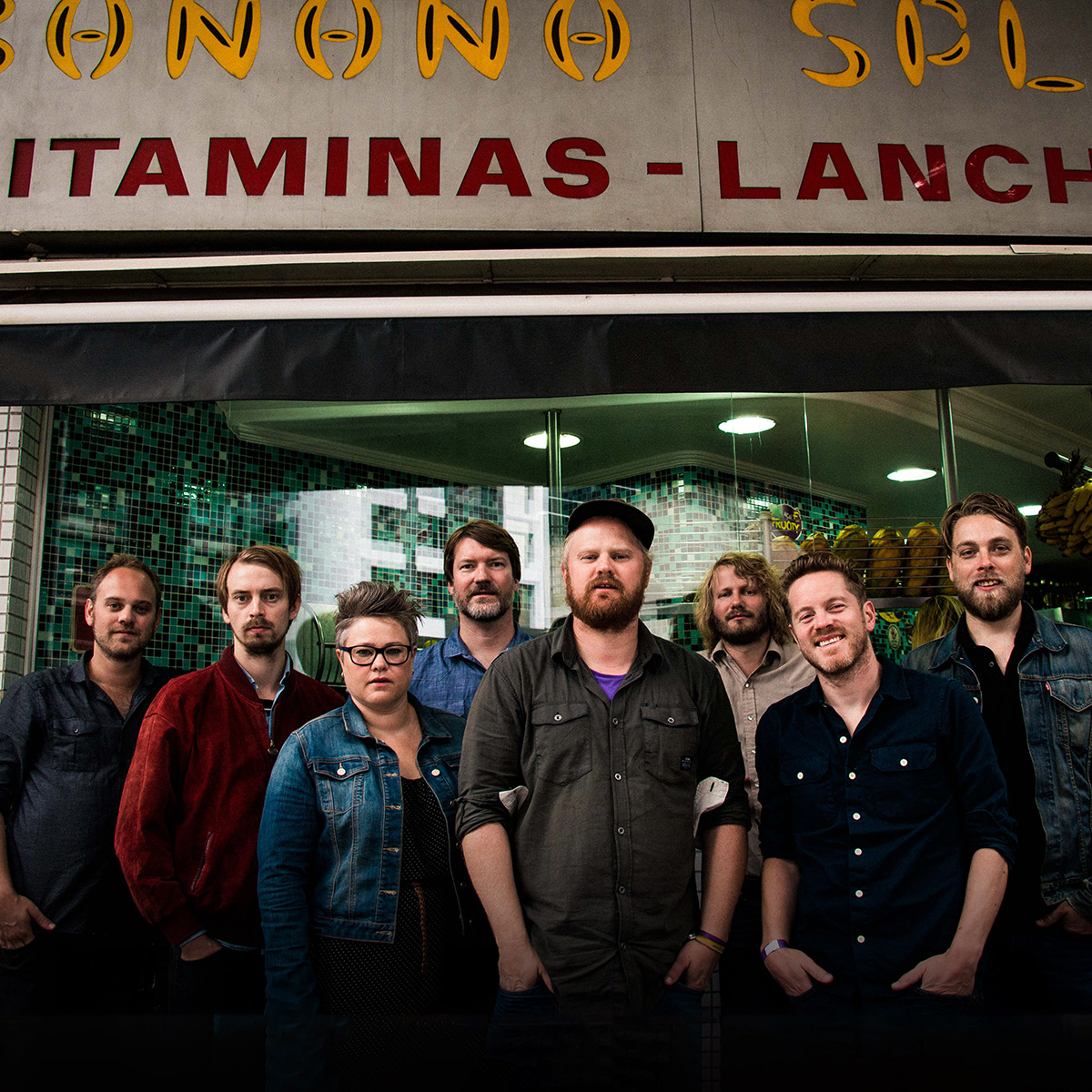
Jaga Jazzist
For those who think they know Jaga Jazzist, the story of this Norwegian supergroup an Starfire – its fifth full- length studio album, hot on the heels of the acclaimed 20th anniversary vinyl box, ’94-’14 – begins with a pop quiz:
Jaga Jazzist is:
(a) A jazz band;
(b) A rock band;
(c) A progressive rock band;
(d) A hip hop group;
(e) A rap group;
(f) A reggae group;
(g) A polka band;
(h) A comedy band;
(i) An electronica group;
(j) A classical ensemble;
(k) A choral ensemble;
(l) All of the above;
(m) None of the above.
The answer is, indeed, both (l) and (m) because across two decades Jaga has been all of these things but, at the end of the day, is really none of them. A point made all the more clear with Starfire- which, in some ways, returns to earlier roots while, at he same time, introducing new elements and, as ever, moving forward…always moving forward.
If Jaga has any rules, there’s really just one: every album must sound like nothing that preceded it. With Starfire, the group that has confounded categorization from inception has delivered yet another album unlike any they’ve ever done before. Yet, at the end of the day – despite touchstones ranging from Gil Evans to Radiohead, My Bloody Valentine to Tortoise, Oslo 13 to Motorpsycho and Fela Kuti to Steve Reich – Starfire still sounds absolutely like nobody but Jaga Jazzist.
The youngest of three siblings that began Jaga in 1994 in the small town of Tønsburg when he was just 14, Lars Horntveth gradually emerged as Jaga’s primary compositional voice. Lars, brother Martin and sister Line all demonstrated a strong-willed distaste for orthodoxy – an early reason why Jaga sounds unlike any other band on any scene. All bandleaders, producers, engineers and/or busy session musicians, Jaga’s members have always been at the heart of Norway’s disproportionately large and vibrant music scene. All the more remarkable, then, that five of its current eight members remain from its early days, with Even Ormestad and Andreas Mjøs still here alongside the Horntveth siblings. Jaga’s out-of-print 1996 debut, Grete Stitz, did extremely well for an indie release, grabbing the ears and eyes of musicians, producers and venue owners at the heart of Norway’s music scene. “We got attention because Jaga was such a bizarre group and Grete Stitz was a very strange album,” says Lars. “We started playing more shows in Oslo, mostly in small clubs; then we signed to the Debut label and recorded the Magazine EP, releasing it in 1998.”
While the 28-minute, four-track Magazine was no less eclectic thanGrete Stitz, it was where Jaga’s voicebegan to emerge more fully, with Lars’ writing facilitating its textural breadth, long-form cinematiccomplexities, intrinsic lyricism and rampant multi-instrumentalism. While yet to release an album that’s anything less than superb, many still feel that 2001’s A Livingroom Hush and Jaga’s 2002 Ninja Tune debut, The Stix, are the group’s best…though Starfire may well change that. What is certain is that Jørgen Træen’s arrival as Jaga’s producer created a monumental paradigm shift: the final piece of Jaga’s puzzle, and a constant challenge to Jaga’s modus operandi. If Magazine represented what it was on the road to becoming, A Livingroom Hush was when Jaga Jazzist arrived.
Another key event for Jaga – already garnering a word-of-mouth reputation for exhilarating live performances – was signing with Ninja Tune. “Ninja helped get us out to the whole world,” says Martin. “We played Japan…went to places we’d never been, with tons of people coming to the shows because they’d heard the name or about the band. Our records had already been in their shops and available online for years; it was really helpful. ”
After two successful albums (A Livingroom Hush selling 15,000 copies in Norway alone), when it came time to record 2005’s What We Must, Træen suggested the group try a different pro-ducer. After an unsuccessful first attempt in Germany, the group returned home to work with Kåre Chr. Vestrheim, one of Norway’s biggest producers. “Working with Kåre was great,” Lars says, “but I missed working with someone from a different musical place. Kåre and I shared so many of the same influences, and I needed resistance; I needed someone that didn’t see all the theory. I never want to make challenging music for the sake of it and Jørgen is always good quality control, asking ‘Why do you have this? Why do you want to do that?’ This is music, and I need people to get in there and fuck with it.”
After releasing and touringWhat We Must, Jaga Jazzist ended up taking an unexpected hiatus, By the time the group returned, full force, in 2009, only six of its members remained – including Erik Johannessen, who joined the group after What We Must was recorded, touring heavily be-fore Jaga’s temporary break. It was also during this break that Øystein Moen joined the band, recording One-Armed Bandit – Jaga’s most overtly progressive rock album, brimming with “the best songs Lars has ever written for Jaga,” asserts Mjøs – alongside fellow Puma bandmate (and short-lived Jaga guitarist) Stian Westerhus. Westerhus played only a handful of gigs after recording the album, and by the time it was released in 2010, Marcus Forsgren was Jaga’s new guitarist – the beginning of Jaga’s most stable lineup, continuing to this day, barring trumpeter Mathias Eick’s 2014 departure after over 15 years with Jaga. Træen, unfortunately, took ill during One-Armed Bandit’s recording sessions, so Tortoise’s John McEntire was recruited for the mix. Universally praised,One-Armed Bandit won Norway’s Spellemannprisen (Grammy) and captured a significant number of new fans. Live, the material took on a life of its own, as heard on 2013’s Live with Britten Sinfonia. Constantly pushing himself to avoid the onset of predictability common in bands achieving Jaga’s longevity, Lars’ epic, cinematic approach to writing has remained paradoxically accessible… singable, even. Still, despite having a primary composer, Jaga’s fundamental philosophy is that everyone in the band contributes to the music’s final shape. This has never been clearer than with Starfire, as Lars – relocating to Los Angelesfor a time (where the bulk of the record was written) – adopted an entirely different recording approach. Rather than inviting the entire band to play together, he became Jaga’s musical ringleader, bringing other members in, one or two at a time, to contribute… and not just instrumentally. With Starfire, Jaga Jazzist ups its ante, returning to a more electronic sound while flipping Lars’ characteristically vertical musical stacks into horizontal sequences. “Starfire is neither an improvised album,”Lars explains, “nor was it notated in scores. Composed and recorded over two years and slowly finding its shape in the studio, the music is as intricate and composed as our other albums, but it’s a 100% studio record. We didn’t rehearse once during this period. The idea was to think about the songs as both original songs and remixes.
Even Ormestad – Bass + keyboards
Andreas Mjøs – Vibraphone, guitars, drums + electronics
Line Horntveth – Tuba + percussion
Martin Horntveth – Drums + drum-machines
Lars Horntveth – Tenor sax, bass-clarinet, guitars + keyboards
Øystein Moen – Keyboards
Erik Johannessen – Trombone + percussion.
